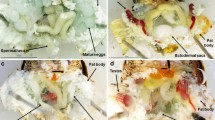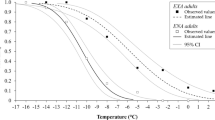Abstract
The cold hardiness and overwintering potential of the southern African pirate bugs, Orius thripoborus (Hesse) and Orius naivashae (Poppius) (Hemiptera: Anthocoridae), were assessed in the laboratory. Diapause traits were studied by observing nymphal development and reproductive performance of adults at 18 °C and three photoperiods (10:14, 12:12 and 14:10 (L:D) h). A 12 h light regime was also tested at 23 °C. A 12 h photoperiod and 18 °C induced reproductive diapause in 84 and 42 % of O. naivashae and O. thripoborus females, respectively. Cold tolerance of adults was measured by determining the supercooling point (SCP, the temperature at which the insect’s body fluids freeze) and lethal time (LT50, the time required to kill 50 % of the population) at 0 and 5 °C. All observed SCPs ranged from −21 to −17 °C. Significantly lower SCP values were observed for acclimated (seven days at 10 °C) O. naivashae females. LT50-values averaged 6.4 and 4.4 days at 0 °C and 11.6 and 7.8 days at 5 °C, for adults of O. thripoborus and O. naivashae, respectively. The findings indicate that O. naivashae is less cold tolerant and has a higher diapause incidence compared with O. thripoborus. Therefore, the latter species may have better potential for use in biological control programmes in the cooler regions of southern Africa or elsewhere.

Similar content being viewed by others
References
Allen CM (2010) Thermal biology and behaviour of two predatory Phytoseiid mites: Amblyseius swirskii (Athias-Henriot) (Acari: Phytoseiidae) and Phytoseiulus longipes (Evans) (Acari: Phytoseiidae). Doctoral dissertation, University of Birmingham
Bale JS (1993) Classes of insect cold hardiness. Funct Ecol 7:751–753
Bale JS (1996) Insect cold hardiness: a matter of life and death. Eur J Entomol 93:369–382
Bale JS, Hayward SAL (2010) Insect overwintering in a changing climate. J Exp Biol 213:980–994
Bale JS, Harrington R, Clough MS (1988) Low temperature mortality of the peach-potato aphid Myzus persicae. Ecol Entomol 13:121–129
Beck SD (1980) Insect photoperiodism, 2nd edn. Academic Press, New York
Bennett LE, Lee RE (1989) Simulated winter to summer transition in diapausing adults of the lady beetle (Hippodamia convergens): supercooling point is not indicative of cold-hardiness. Physiol Entomol 14:361–367
Berkvens N, Bale JS, Berkvens D, Tirry L, De Clercq P (2010) Cold tolerance of the harlequin ladybird Harmonia axyridis in Europe. J Insect Physiol 56:438–444
Bonte M, De Clercq P (2011) Influence of predator density, diet and living substrate on developmental fitness of Orius laevigatus. J Appl Entomol 135:343–350
Bonte J, De Ro M, Conlong D, De Clercq P (2012a) Thermal biology of the predatory bugs Orius thripoborus and O. naivashae (Hemiptera: Anthocoridae). Environ Entomol 41:989–996
Bonte J, Vangansbeke D, Maes S, Bonte M, Conlong D, De Clercq P (2012b) Moisture source and diet affect development and reproduction of Orius thripoborus and Orius naivashae, two predatory anthocorids from southern Africa. J Insect Sci 12:1–16
Bonte J, De Hauwere L, Conlong D, De Clercq P (2015) Predation capacity, development and reproduction of the southern African flower bugs Orius thripoborus and Orius naivashae (Hemiptera: Anthocoridae) on various prey. Biol Control 86:52–59
Bowler K, Terblanche JS (2008) Insect thermal tolerance: what is the role of ontogeny, ageing and senescence? Biol Rev 83:339–355
Brand South Africa (2015) South Africa’s weather and climate. http://www.southafrica.info. Accessed date on Feb 2 2015
Bueno VHP, Carvalho LM, van Lenteren JC (2014) Performance of Orius insidiosus after storage, exposure to dispersal material, handling and shipment processes. Bull Insectol 67:175–183
Callebaut B, van Baal E, Vandekerkhove B, Bolckmans K, De Clercq P (2004) A fecundity test for assessing the quality of Macrolophus caliginosus reared on artificial diets. Parasitica 60:9–14
Chown SL, Terblanche JS (2006) Physiological diversity in insects: ecological and evolutionary contexts. Adv Insect Physiol 33:50–152
Danks HV (1987) Insect dormancy: an ecological perspective (Biological Survey of Canada Monograph Series, No 1). Entomological Society of Canada
Denlinger DL (1991) Relationship between cold hardiness and diapause. In: Lee LE Jr, Denlinger DL (eds) Insects at low temperature. Chapman and Hall, New York, pp 174–198
Dennil GB (1992) Orius thripoborus (Anthocoridae), a potential biocontrol agent of Heliothrips haemorrhoidalis and Selenothrips rubrocinctus (Thripidae) on avocado fruit in the Eastern Transvaal. S Afr Avocado Growers’ Assoc Yearbook 15:55–56
European and Mediterranean Plant Protection Organization (EPPO) (2014) PQR—EPPO database on quarantine pests. http://www.eppo.int. Accessed date on Aug 27 2014
Hart AJ, Bale JS, Tullett AG, Worland MR, Walters KFA (2002a) Effects of temperature on the establishment potential of the predatory mite Amblyseius californicus McGregor (Acari: Phytoseiidae) in the UK. J Insect Physiol 48:593–599
Hart AJ, Tullett AG, Bale JS, Walters KF (2002b) Effects of temperature on the establishment potential in the UK of the non-native glasshouse biocontrol agent Macrolophus caliginosus. Physiol Entomol 27:112–123
Hatherly IS, Hart AJ, Tullett AG, Bale JS (2005) Use of thermal data as a screen for the establishment potential of non-native biological control agents in the UK. BioControl 50:687–698
Hatherly IS, Pedersen BP, Bale JS (2008) Establishment potential of the predatory mirid Dicyphus hesperus in northern Europe. BioControl 53:589–601
Hernández LM, Stonedahl GM (1999) A review of the economically important species of the genus Orius (Heteroptera: Anthocoridae) in East Africa. J Nat Hist 33:543–568
Hesse AJ (1940) A new species of Thripleps (Hemiptera-Heteroptera, Anthocoridae) predaceous of the citrus thrips (Scirtothrips aurantii Faure) in the Transvaal. J Entomol Soc South Afr 3:66–71
Hilbe J (2011) Negative binomial regression, 2nd edn. Cambridge University Press, Cambridge
Hughes GE, Bale JS, Sterk G (2009) Thermal biology and establishment potential in temperate climates of the predatory mirid Nesidiocoris tenuis. BioControl 54:785–795
IBM Corp (2012) IBM SPSS statistics for windows, Version 21.0. IBM Corp, Armonk
Ito K, Nakata T (1998a) Diapause and survival in winter in two species of predatory bugs, Orius sauteri and O. minutus. Entomol Exp Appl 89:271–276
Ito K, Nakata T (1998b) Effect of photoperiod on reproductive diapause in the predatory bugs, Orius sauteri (Poppius) and O. minutus (Linnaeus) (Heteroptera: Anthocoridae). Appl Entomol Zool 33:115–120
Ito K, Nakata T (2000) Geographical variation of photoperiodic response in the females of a predatory bug, Orius sauteri (Poppius) (Heteroptera: Anthocoridae) from northern Japan. Appl Entomol Zool 35:101–105
Kiritani Y (1985) Effect of stationary and changing photoperiods on nymphal development in Carbula humerigera (Heteroptera: Pentatomidae). Appl Entomol Zool 20:257–263
Kirk WD, Terry LI (2003) The spread of the western flower thrips Frankliniella occidentalis (Pergande). Agric For Entomol 5:301–310
Kobayashi T, Osakabe M (2009) Pre-winter copulation enhances overwintering success of Orius females (Heteroptera: Anthocoridae). Appl Entomol Zool 44:47–52
Kohno K (1997) Photoperiodic effect on incidence of reproductive diapause in Orius sauteri and O. minutus (Heteroptera: Anthocoridae). Appl Entomol Zool 32:644–648
Leather SR, Walters KF, Bale JS (1995) The ecology of insect overwintering. Cambridge University Press, Cambridge
Lee RE, Strong-Gunderson JM, Lee MR, Grove KS, Riga TJ (1991) Isolation of ice nucleating active bacteria from insects. J Exp Zool 257:124–127
Lopatina EB, Balashov SV, Kipyatkov VE (2007) First demonstration of the influence of photoperiod on the thermal requirements for development in insects and in particular the linden-bug, Pyrrhocoris apterus (Heteroptera: Pyrrhocoridae). Eur J Entomol 104:23–31
Maes S, Machtelinckx T, Moens M, Grégoire JC, De Clercq P (2012) The influence of acclimation, endosymbionts and diet on the supercooling capacity of the predatory bug Macrolophus pygmaeus. BioControl 57:643–651
Maes S, Grégoire JC, De Clercq P (2015) Cold tolerance of the predatory ladybird Cryptolaemus montrouzieri. BioControl 60:199–207
Masaki S (1990) Opportunistic diapause in the subtropical ground cricket, Dianemobius fascipes. In: Gilbert F (ed) Insect life cycles. Genetics, evolution and co-ordination. Springer, London, pp 125–141
McCullagh P, Nelder JA (1989) Generalized linear models. Chapman and Hall, New York
Morse JG, Hoddle MS (2006) Invasion biology of thrips. Annu Rev Entomol 51:67–89
Musolin DL, Ito K (2008) Photoperiodic and temperature control of nymphal development and induction of reproductive diapause in two predatory Orius bugs: interspecific and geographic differences. Physiol Entomol 33:291–301
Musolin DL, Saulich AKh (1997) Photoperiodic control of nymphal growth in true bugs (Heteroptera). Entomol Rev 77:768–780
Musolin DL, Tsytsulina K, Ito K (2004) Photoperiodic and temperature control of reproductive diapause induction in the predatory bug Orius strigicollis (Heteroptera: Anthocoridae) and its implications for biological control. Biol Control 31:91–98
Nakashima Y, Hirose Y (1997) Winter reproduction and photoperiodic effects on diapause induction of Orius tantillus (Motschulsky) (Heteroptera: Anthocoridae), a predator of Thrips palmi. Appl Entomol Zool 32:403–405
Pazyuk IM, Musolin DL, Reznik SY (2014) Geographic variation in thermal and photoperiodic effects on development of zoophytophagous plant bug Nesidiocoris tenuis. J Appl Entomol 138:36–44
Riudavets J (1995) Predators of Frankliniella occidentalis (Perg.) and Thrips tabaci Lind.: a review. In: Loomans AJM, van Lenteren JC, Tommasini MG, Maini S, Riudavets J (eds) Biological control of thrips pests. Wageningen Agricultural University, Wageningen, pp 43–87
Ruberson JR, Bush L, Kring TJ (1991) Photoperiodic effect on diapause induction and development in the predator Orius insidiosus (Heteroptera: Anthocoridae). Environ Entomol 20:786–789
Ruberson JR, Shen YJ, Kring TJ (2000) Photoperiodic sensitivity and diapause in the predator Orius insidiosus (Heteroptera: Anthocoridae). Ann Entomol Soc Am 93:1123–1130
Saulich AKh, Musolin DL (2009) Seasonal development and ecology of anthocorids (Heteroptera, Anthocoridae). Entomol Rev 89:501–528
Saunders DS (2002) Insect clocks, 3rd edn. Elsevier, Amsterdam
Shimizu K, Fujisaki K (2006) Geographic variation in diapause induction under constant and changing conditions in Helicoverpa armigera. Entomol Exp Appl 121:253–260
Shimizu T, Kawasaki K (2001) Geographic variability in diapause response of Japanese Orius species. Entomol Exp Appl 98:303–316
South African Weather Service (2015) About climate at SAWS. http://www.weathersa.co.za. Accessed date on Feb 2 2015
Tanaka S, Zhu DH (2003) Presence of three diapauses in a subtropical cockroach: control mechanisms and adaptive significance. Physiol Entomol 28:323–330
Tauber MJ, Tauber CA, Masaki S (1986) Seasonal adaptations of insects. Oxford University Press, Oxford
Tommasini MG, Nicoli G (1995) Evaluation of Orius spp. as biological control agents of thrips pests: initial experiments on the existence of diapause in Orius laevigatus. Meded Fac Landbouwwet Univ Gent 60:901–907
Tommasini MG, Nicoli G (1996) Evaluation of Orius spp. as biological control agents of thrips pests. Further experiments on the existence of diapause in Orius laevigatus. Bull OILB/SROP (France) 19:183–186
van Damme V, Berkvens N, Moerkens R, Berckmoes E, Wittemans L, De Vis R, Casteels H, Tirry L, De Clercq P (2015) Overwintering potential of the invasive leafminer Tuta absoluta (Meyrick) (Lepidoptera: Gelechiidae) as a pest in greenhouse tomato production in Western Europe. J Pest Sci 88:533–541
van den Meiracker RVD (1994) Induction and termination of diapause in Orius predatory bugs. Entomol Exp Appl 73:127–137
van den Meiracker RAF, Ramakers PMJ (1991) Biological control of the western flower thrips Frankliniella occidentalis, in sweet pepper, with the anthocorid predator Orius insidiosus. Meded Fac Landbouwwet Univ Gent 56:241–249
Watanabe M (2002) Cold tolerance and myo-inositol accumulation in overwintering adults of a lady beetle, Harmonia axyridis (Coleoptera: Coccinellidae). Eur J Entomol 99:5–10
Way MJ, Stiller M, Leslie GW, Conlong DE, Keeping MG, Rutherford RS (2006) Fulmekiola serrata (Kobus) (Thysanoptera: Thripidae), a new pest in southern African sugarcane. Afr Entomol 14:401–403
Worland MR, Block W (1999) Ice-nucleating bacteria from the guts of two sub-Antarctic beetles, Hydromedion sparsutum and Perimylops antarcticus (Perimylopidae). Cryobiol 38:60–67
Zhang SC, Zhou XM, Wang XP, Lei CL (2008) Oviposition on preference of Orius similis and preservation condition of eggs. Chin Bull Entomol 45:600–603
Author information
Authors and Affiliations
Corresponding author
Additional information
Handling Editor: Marta Montserrat.
Rights and permissions
About this article
Cite this article
Bonte, J., Musolin, D.L., Conlong, D. et al. Diapause and winter survival of two Orius species from southern Africa. BioControl 61, 519–532 (2016). https://doi.org/10.1007/s10526-016-9730-7
Received:
Accepted:
Published:
Issue Date:
DOI: https://doi.org/10.1007/s10526-016-9730-7




